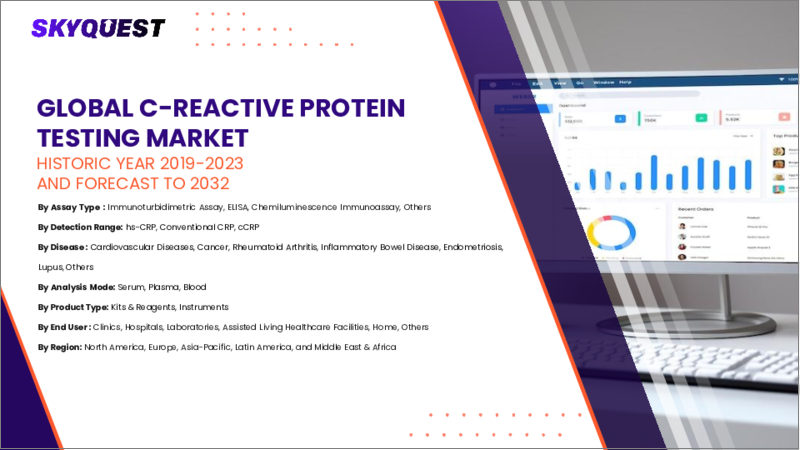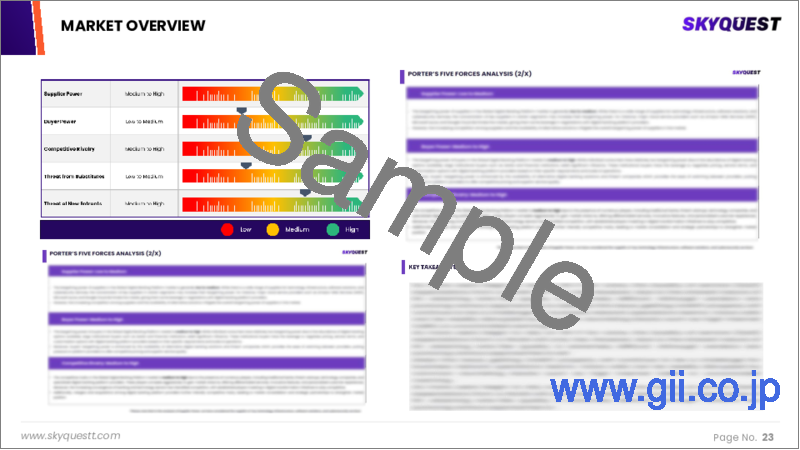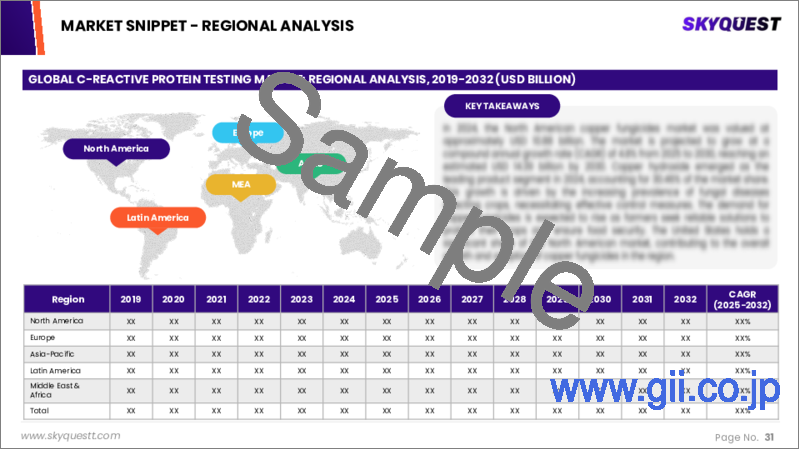|
|
市場調査レポート
商品コード
1619137
C反応性タンパク検査市場規模、シェア、成長分析、アッセイタイプ別、検出範囲別、疾患領域別、最終用途別、地域別 - 産業別予測、2024~2031年C-Reactive Protein Testing Market Size, Share, Growth Analysis, By Assay Type (Immunoturbidimetric Assay, Elisa), By Detection Range (HS-CRP, Conventional CRP), By Disease Area, By End-Use, By Region - Industry Forecast 2024-2031 |
||||||
|
|||||||
| C反応性タンパク検査市場規模、シェア、成長分析、アッセイタイプ別、検出範囲別、疾患領域別、最終用途別、地域別 - 産業別予測、2024~2031年 |
|
出版日: 2024年12月18日
発行: SkyQuest
ページ情報: 英文 260 Pages
納期: 3~5営業日
|
全表示
- 概要
- 目次
C反応性タンパク検査の世界市場規模は、2022年に45億米ドルと評価され、2023年の46億米ドルから2031年には55億2,000万米ドルに成長し、予測期間(2024-2031年)のCAGRは2.3%で成長する見通しです。
C反応性タンパク検査の世界市場は、特異性、感度、迅速な現場での疾患診断を強化するナノテクノロジーの進歩に牽引され、大きな成長が見込まれています。迅速な診断ツールに対する需要の高まりを受けて、CRP検査用の新しいポイント・オブ・ケア・アッセイが登場しています。Mohammed VI大学の調査は、SARS-CoV-2の重症度評価におけるCRPの可能性を明らかにし、CRPの重要性をさらに高めています。さらに、炎症性疾患、糖尿病、がんの有病率の上昇、子宮内膜症の罹患率の増加、診断への資金提供の増加は、市場の拡大に拍車をかけると予想されます。CDCの報告によると、米国では2,010万人以上の成人が冠動脈疾患に罹患しており、この数は今後も増加すると予想されています。
目次
イントロダクション
- 調査の目的
- 調査範囲
- 定義
調査手法
- 情報調達
- 二次データと一次データの方法
- 市場規模予測
- 市場の前提条件と制限
エグゼクティブサマリー
- 世界市場の見通し
- 供給と需要の動向分析
- セグメント別機会分析
市場力学と見通し
- 市場概要
- 市場規模
- 市場力学
- 促進要因と機会
- 抑制要因と課題
- ポーターの分析
主な市場の考察
- 重要成功要因
- 競合の程度
- 主な投資機会
- 市場エコシステム
- 市場の魅力指数(2023年)
- PESTEL分析
- マクロ経済指標
- バリューチェーン分析
- 価格分析
- ケーススタディ分析
C反応性タンパク検査市場規模:アッセイタイプ別
- 市場概要
- 免疫比濁法
- エリサ
- 臨床
- 非臨床
- 化学発光免疫測定法
- その他
C反応性タンパク検査市場規模:検出範囲別
- 市場概要
- HS-CRP
- 従来のCRP
- CCRP
C反応性タンパク検査市場規模:疾患領域別
- 市場概要
- 心血管疾患
- がん
- 関節リウマチ
- 炎症性腸疾患
- 子宮内膜症
- ループス
- その他
C反応性タンパク検査市場規模:最終用途別
- 市場概要
- クリニック
- エンティティ別
- 医師のオフィス
- 小規模クリニック
- その他
- 設定別
- 都会の雰囲気
- 田舎の雰囲気
- 病院
- 都会の雰囲気
- 田舎の雰囲気
- 研究所
- 都会の雰囲気
- 田舎の雰囲気
- 介護付き生活ヘルスケア施設
- 都会の雰囲気
- 田舎の雰囲気
- 家庭
- その他
C反応性タンパク検査市場規模
- 北米
- 米国
- カナダ
- 欧州
- ドイツ
- スペイン
- フランス
- 英国
- イタリア
- その他欧州地域
- アジア太平洋地域
- 中国
- インド
- 日本
- 韓国
- その他アジア太平洋地域
- ラテンアメリカ
- ブラジル
- その他ラテンアメリカ地域
- 中東・アフリカ
- GCC諸国
- 南アフリカ
- その他中東・アフリカ
競合情報
- 上位5社の比較
- 主要企業の市場ポジショニング(2023年)
- 主な市場企業が採用した戦略
- 市場の最近の動向
- 企業の市場シェア分析(2023年)
- 主要企業の企業プロファイル
- 会社概要
- 製品ポートフォリオ分析
- セグメント別シェア分析
- 収益の前年比比較(2021-2023)
主要企業プロファイル
- Thermo Fisher Scientific Inc.
- Roche Diagnostics
- Abbott Laboratories
- Beckman Coulter
- Bio-Rad Laboratories
- Siemens Healthcare
- Quest Diagnostics
- Ortho Clinical Diagnostics
- Randox Laboratories
- Boditech Med Inc.
- Merck Millipore
- BioMerieux
- Trinity Biotech
- Becton, Dickinson and Company(BD)
- Sekisui Diagnostics
- Tosoh Bioscience Inc.
- DiaSorin S.p.A.
- Fujifilm Corporation
結論と推奨事項
Global C-Reactive Protein Testing Market size was valued at USD 4.5 billion in 2022 and is poised to grow from USD 4.6 billion in 2023 to USD 5.52 billion by 2031, growing at a CAGR of 2.3% during the forecast period (2024-2031).
The global market for C-reactive protein testing is poised for significant growth, driven by advancements in nanotechnology that enhance specificity, sensitivity, and rapid on-site disease diagnosis. New point-of-care assays for CRP testing are emerging, responding to the increasing demand for swift diagnostic tools. Research from Mohammed VI University highlights CRP's potential in assessing SARS-CoV-2 severity, further cementing its relevance. Additionally, the rising prevalence of inflammatory disorders, diabetes, and cancers, alongside a growing incidence of endometriosis and increased funding in diagnostics, is expected to fuel market expansion. Notably, the CDC reported that over 20.1 million adults in the U.S. suffer from coronary artery disease, a number anticipated to rise, thereby amplifying market opportunities in this sector.
Top-down and bottom-up approaches were used to estimate and validate the size of the Global C-Reactive Protein Testing market and to estimate the size of various other dependent submarkets. The research methodology used to estimate the market size includes the following details: The key players in the market were identified through secondary research, and their market shares in the respective regions were determined through primary and secondary research. This entire procedure includes the study of the annual and financial reports of the top market players and extensive interviews for key insights from industry leaders such as CEOs, VPs, directors, and marketing executives. All percentage shares split, and breakdowns were determined using secondary sources and verified through Primary sources. All possible parameters that affect the markets covered in this research study have been accounted for, viewed in extensive detail, verified through primary research, and analyzed to get the final quantitative and qualitative data.
Global C-Reactive Protein Testing Market Segmental Analysis
Global C-Reactive Protein Testing Market is segmented by assay type, detection range, disease area, end-use and region. Based on assay type, the market is segmented into immunoturbidimetric assay, ELISA, chemiluminescence immunoassay and others. Based on detection range, the market is segmented into HS-CRP, conventional CRP and cCRP. Based on disease area, the market is segmented into cardiovascular diseases, cancer, rheumatoid arthritis, inflammatory bowel disease, endometriosis, lupus and others. Based on end-use, the market is segmented into clinics, hospitals, laboratories, assisted living healthcare facilities, home and others. Based on region, the market is segmented into North America, Europe, Asia Pacific, Latin America and Middle East & Africa.
Driver of the Global C-Reactive Protein Testing Market
The global C-reactive protein testing market is poised for significant growth, primarily fueled by the increasing prevalence of cardiovascular diseases. With over 800,000 fatalities attributed to cardiovascular conditions annually in the United States alone, the demand for effective C-reactive protein testing methods is surging. Additionally, the ongoing research and development aimed at enhancing these testing methodologies will further propel market expansion. The combination of an ageing population and a rising incidence of diabetes mellitus also contributes to this upward trend, indicating a robust market potential in the foreseeable future as healthcare providers seek better diagnostic solutions.
Restraints in the Global C-Reactive Protein Testing Market
The global C-Reactive Protein Testing market is likely to face significant restraints primarily due to low awareness about CRP testing and the limited availability of advanced technologies in lower and medium-sized economies worldwide. This lack of knowledge can lead to underutilization of these important diagnostic tools, hindering market expansion. Furthermore, the high costs associated with CRP testing procedures and the substantial initial investments required to establish appropriate setups could further inhibit growth in the market. Together, these factors pose considerable challenges that may slow down the adoption and proliferation of C-reactive protein testing solutions globally during the forecast period.
Market Trends of the Global C-Reactive Protein Testing Market
The global C-Reactive Protein (CRP) testing market is experiencing significant growth, driven by heightened awareness programs and government initiatives aimed at educating the public on chronic disease prevention and treatment. This surge in awareness has led to the widespread integration of CRP testing in routine clinical practices, particularly in developed regions such as the United States, Germany, France, and Japan. As healthcare providers increasingly prioritize CRP tests for assessing inflammation and guiding treatment decisions, the market is poised for robust expansion in the coming years, reflecting a shift towards proactive health management and early disease detection.
Table of Contents
Introduction
- Objectives of the Study
- Scope of the Report
- Definitions
Research Methodology
- Information Procurement
- Secondary & Primary Data Methods
- Market Size Estimation
- Market Assumptions & Limitations
Executive Summary
- Global Market Outlook
- Supply & Demand Trend Analysis
- Segmental Opportunity Analysis
Market Dynamics & Outlook
- Market Overview
- Market Size
- Market Dynamics
- Drivers & Opportunities
- Restraints & Challenges
- Porters Analysis
- Competitive rivalry
- Threat of substitute
- Bargaining power of buyers
- Threat of new entrants
- Bargaining power of suppliers
Key Market Insights
- Key Success Factors
- Degree of Competition
- Top Investment Pockets
- Market Ecosystem
- Market Attractiveness Index, 2023
- PESTEL Analysis
- Macro-Economic Indicators
- Value Chain Analysis
- Pricing Analysis
- Case Study Analysis
Global C-Reactive Protein Testing Market Size by Assay Type & CAGR (2024-2031)
- Market Overview
- Immunoturbidimetric Assay
- Elisa
- Clinical
- Non-Clinical
- Chemiluminescence Immunoassay
- Others
Global C-Reactive Protein Testing Market Size by Detection Range & CAGR (2024-2031)
- Market Overview
- HS-CRP
- Conventional CRP
- CCRP
Global C-Reactive Protein Testing Market Size by Disease Area & CAGR (2024-2031)
- Market Overview
- Cardiovascular Diseases
- Cancer
- Rheumatoid Arthritis
- Inflammatory Bowel Disease
- Endometriosis
- Lupus
- Others
Global C-Reactive Protein Testing Market Size by End-Use & CAGR (2024-2031)
- Market Overview
- Clinics
- By Entity
- Physician Offices
- Small Clinics
- Others
- By Settings
- Urban Setting
- Rural Setting
- Hospitals
- Urban Setting
- Rural Setting
- Laboratories
- Urban Setting
- Rural Setting
- Assisted Living Healthcare Facilities
- Urban Setting
- Rural Setting
- Home
- Others
Global C-Reactive Protein Testing Market Size & CAGR (2024-2031)
- North America (Assay Type, Detection Range, Disease Area, End-Use)
- US
- Canada
- Europe (Assay Type, Detection Range, Disease Area, End-Use)
- Germany
- Spain
- France
- UK
- Italy
- Rest of Europe
- Asia Pacific (Assay Type, Detection Range, Disease Area, End-Use)
- China
- India
- Japan
- South Korea
- Rest of Asia-Pacific
- Latin America (Assay Type, Detection Range, Disease Area, End-Use)
- Brazil
- Rest of Latin America
- Middle East & Africa (Assay Type, Detection Range, Disease Area, End-Use)
- GCC Countries
- South Africa
- Rest of Middle East & Africa
Competitive Intelligence
- Top 5 Player Comparison
- Market Positioning of Key Players, 2023
- Strategies Adopted by Key Market Players
- Recent Developments in the Market
- Company Market Share Analysis, 2023
- Company Profiles of All Key Players
- Company Details
- Product Portfolio Analysis
- Company's Segmental Share Analysis
- Revenue Y-O-Y Comparison (2021-2023)
Key Company Profiles
- Thermo Fisher Scientific Inc.
- Company Overview
- Business Segment Overview
- Financial Updates
- Key Developments
- Roche Diagnostics
- Company Overview
- Business Segment Overview
- Financial Updates
- Key Developments
- Abbott Laboratories
- Company Overview
- Business Segment Overview
- Financial Updates
- Key Developments
- Beckman Coulter
- Company Overview
- Business Segment Overview
- Financial Updates
- Key Developments
- Bio-Rad Laboratories
- Company Overview
- Business Segment Overview
- Financial Updates
- Key Developments
- Siemens Healthcare
- Company Overview
- Business Segment Overview
- Financial Updates
- Key Developments
- Quest Diagnostics
- Company Overview
- Business Segment Overview
- Financial Updates
- Key Developments
- Ortho Clinical Diagnostics
- Company Overview
- Business Segment Overview
- Financial Updates
- Key Developments
- Randox Laboratories
- Company Overview
- Business Segment Overview
- Financial Updates
- Key Developments
- Boditech Med Inc.
- Company Overview
- Business Segment Overview
- Financial Updates
- Key Developments
- Merck Millipore
- Company Overview
- Business Segment Overview
- Financial Updates
- Key Developments
- BioMerieux
- Company Overview
- Business Segment Overview
- Financial Updates
- Key Developments
- Trinity Biotech
- Company Overview
- Business Segment Overview
- Financial Updates
- Key Developments
- Becton, Dickinson and Company (BD)
- Company Overview
- Business Segment Overview
- Financial Updates
- Key Developments
- Sekisui Diagnostics
- Company Overview
- Business Segment Overview
- Financial Updates
- Key Developments
- Tosoh Bioscience Inc.
- Company Overview
- Business Segment Overview
- Financial Updates
- Key Developments
- DiaSorin S.p.A.
- Company Overview
- Business Segment Overview
- Financial Updates
- Key Developments
- Fujifilm Corporation
- Company Overview
- Business Segment Overview
- Financial Updates
- Key Developments






